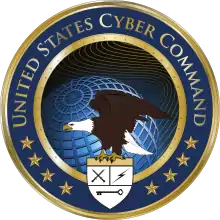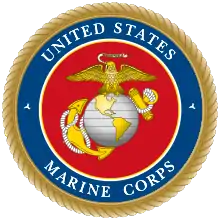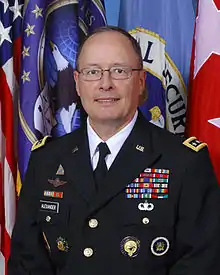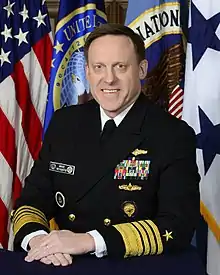United States Cyber Command
United States Cyber Command (USCYBERCOM) is one of the eleven unified combatant commands of the United States Department of Defense (DoD). It unifies the direction of cyberspace operations, strengthens DoD cyberspace capabilities, and integrates and bolsters DoD's cyber expertise.
| United States Cyber Command | |
|---|---|
 Emblem of the U.S. Cyber Command | |
| Founded | 21 May 2010 |
| Country | |
| Type | Unified combatant command and cyber force |
| Role | Cyberwarfare |
| Part of | U.S. Department of Defense |
| Garrison/HQ | Fort George G. Meade, Maryland, U.S. |
| Nickname(s) | "USCYBERCOM", "CYBERCOM" |
| Website | cybercom.mil |
| Commanders | |
| Commander | |
| Deputy Commander | |
| Senior Enlisted Leader | CSM Sheryl D. Lyon[1] |
USCYBERCOM was created in mid-2009 at the National Security Agency (NSA) headquarters in Fort George G. Meade, Maryland. It cooperates with NSA networks and has been concurrently headed by the director of the National Security Agency since its inception.[2] While originally created with a defensive mission in mind, it has increasingly been viewed as an offensive force.[2] On 18 August 2017, it was announced that USCYBERCOM would be elevated to the status of a full and independent unified combatant command.[3] This elevation occurred on 4 May 2018.
Mission statement
According to the US Department of Defense (DoD):
USCYBERCOM plans, coordinates, integrates, synchronizes and conducts activities to: direct the operations and defense of specified Department of Defense information networks and; prepare to, and when directed, conduct full spectrum military cyberspace operations in order to enable actions in all domains, ensure US/Allied freedom of action in cyberspace and deny the same to our adversaries.[4][5]
The text "9ec4c12949a4f31474f299058ce2b22a", located in the command's emblem, is the MD5 hash of their mission statement.[5]
The command is charged with pulling together existing cyberspace resources, creating synergies and synchronizing war-fighting effects to defend the information security environment. USCYBERCOM is tasked with centralizing command of cyberspace operations, strengthening DoD cyberspace capabilities, and integrating and bolstering DoD's cyber expertise.[6][7]
Organization
USCYBERCOM is an armed forces unified command under Department of Defense (DoD).
Service components
U.S. Cyber Command is composed of several service components, units from military services who will provide Joint services to Cyber Command.
- Army Cyber Command (Army)
- Fleet Cyber Command/Tenth Fleet (Navy)[11][12]
- Naval Network Warfare Command
- Navy Cyber Defense Operations Command
- Naval Information Operation Commands
- Combined Task Forces
- 16th Air Force (Air Force)[13]
- Marine Corps Cyberspace Command (Marine Corps)[14]
Cyber teams
In 2015, the U.S. Cyber Command added 133 new cyber teams.[15] The breakdown was:
- Thirteen National Mission Teams to defend against broad cyberattacks
- Sixty-eight Cyber Protection Teams to defend priority DoD networks and systems against priority threats
- Twenty-seven Combat Mission Teams to provide integrated cyberspace attacks in support of operational plans and contingency operations
- Twenty-five Cyber Support Teams to provide analytic and planning support to the national mission and combat mission teams.
Background
An intention by the U.S. Air Force to create a 'cyber command' was announced in October 2006.[16] An Air Force Cyber Command was created in a provisional status in November 2006. However, in October 2008, it was announced the command would not be brought into permanent activation.
On 23 June 2009, the Secretary of Defense directed the Commander of U.S. Strategic Command (USSTRATCOM) to establish USCYBERCOM. In May 2010, General Keith Alexander outlined his views in a report for the United States House Committee on Armed Services subcommittee:[17][18][19][20][21]
My own view is that the only way to counteract both criminal and espionage activity online is to be proactive. If the U.S. is taking a formal approach to this, then that has to be a good thing. The Chinese are viewed as the source of a great many attacks on western infrastructure and just recently, the U.S. electrical grid. If that is determined to be an organized attack, I would want to go and take down the source of those attacks. The only problem is that the Internet, by its very nature, has no borders and if the U.S. takes on the mantle of the world's police; that might not go down so well.
Initial operational capability was attained on 21 May 2010. General Alexander was promoted to four-star rank, becoming one of 38 U.S. generals, and took charge of U.S. Cyber Command in a ceremony at Fort Meade that was attended by Commander of U.S. Central Command GEN David Petraeus, and Secretary of Defense Robert M. Gates.[22][23][24][25] USCYBERCOM reached full operational capability on 31 October 2010.[26]
The command assumed responsibility for several existing organizations. The Joint Task Force for Global Network Operations (JTF-GNO) and the Joint Functional Component Command for Network Warfare (JFCC-NW) were absorbed by the command. The Defense Information Systems Agency, where JTF-GNO operated, provides technical assistance for network and information assurance to USCYBERCOM, and is moving its headquarters to Fort Meade.[27]
President Obama signed into law, on 23 December 2016, the National Defense Authorization Act (NDAA) for fiscal year (FY) 2017, which elevated USCYBERCOM to a unified combatant command. The FY 2017 NDAA also specified that the dual-hatted arrangement of the commander of USCYBERCOM will not be terminated until the Secretary of Defense and Chairman of the Joint Chiefs of Staff jointly certify that ending this arrangement will not pose risks to the military effectiveness of CYBERCOM that are unacceptable to the national security interests of the United States.[28]
Concerns
There are concerns that the Pentagon and NSA will overshadow any civilian cyber defense efforts.[29] There are also concerns on whether the command will assist in civilian cyber defense efforts.[30] According to Deputy Secretary of Defense William J. Lynn, the command "will lead day-to-day defense and protection of all DoD networks. It will be responsible for DoD's networks – the dot-mil world. Responsibility for federal civilian networks – dot-gov – stays with the Department of Homeland Security, and that's exactly how it should be."[31] Alexander notes, however, that if faced with cyber hostilities an executive order could expand Cyber Command's spectrum of operations to include, for instance, assisting the Department of Homeland Security in defense of their networks.[32]
Some military leaders claim that the existing cultures of the Army, Navy, and Air Force are fundamentally incompatible with that of cyber warfare.[33] Major Robert Costa (USAF) even suggested a sixth branch of the military, an Information (Cyber) Service with Title 10 responsibilities analogous to its sister services in 2002 noting:
While no one [Instrument of National Power] operates in a vacuum... Information increasingly underpins the other three [Diplomatic, Economic and Military], yet has proven to be the most vulnerable, even as US society becomes more dependent on it in peace, conflict, and war. To attack these centers of gravity, an adversary will use the weakest decisive point, ... the Information IOP. In addition, the other IOPs benefit from Unity of Effort--Constitutional balances of power ensure the Diplomatic and Military IOPs exercised by the President in concert with Congress are focused, while the Economic IOP achieves Unity of Action through international market controls and an international body of law. [In 2002], [t]he Information IOP however, [was] rudderless, lacking both Unity of Action and Unity of Command.[34]
Others have also discussed the creation of a cyber-warfare branch.[35][36] Lieutenant Colonel Gregory Conti[37] and Colonel John "Buck" Surdu (chief of staff of the United States Army Research, Development and Engineering Command) stated that the three major services are properly positioned to fight kinetic wars, and they value skills such as marksmanship, physical strength, the ability to leap out of airplanes and lead combat units under enemy fire.[36]
Conti and Surdu reasoned, "Adding an efficient and effective cyber branch alongside the Army, Navy and Air Force would provide our nation with the capability to defend our technological infrastructure and conduct offensive operations. Perhaps more important, the existence of this capability would serve as a strong deterrent for our nation's enemies."[38]
In response to concerns about the military's right to respond to cyber attacks, General Alexander stated "The U.S. must fire back against cyber attacks swiftly and strongly and should act to counter or disable a threat even when the identity of the attacker is unknown" prior to his confirmation hearings before the United States Congress. This came in response to incidents such as a 2008 operation to take down a government-run extremist honeypot in Saudi Arabia. "Elite U.S. military computer specialists, over the objections of the CIA, mounted a cyberattack that dismantled the online forum".[39]
"The new U.S. Cyber Command needs to strike a balance between protecting military assets and personal privacy." stated Alexander, in a Defense Department release. If confirmed, Alexander said, his main focus will be on building capacity and capability to secure the networks and educating the public on the command's intent.
"This command is not about an effort to militarize cyber space," he said. "Rather, it's about safeguarding our military assets."[40]
In July 2011, Deputy Defense Secretary William Lynn announced in a conference that "We have, within Cyber Command, a full spectrum of capabilities, but the thrust of the strategy is defensive." "The strategy rests on five pillars, he said: treat cyber as a domain; employ more active defenses; support the Department of Homeland Security in protecting critical infrastructure networks; practice collective defense with allies and international partners; and reduce the advantages attackers have on the Internet."[41]
In 2013, USCYBERCOM held a classified exercise in which reserve officers (with extensive experience in their civilian cyber-security work) easily defeated active duty cybermen.[42] In 2015 Eric Rosenbach, the principal cyber adviser to Defense Secretary Ash Carter, said DoD was looking at alternatives to staffing with just active-duty military.[43] Beginning that year, USCYBERCOM added 133 teams (staffing out at 6,000 people), with the intent that at least 15% of the personnel would be reserve cyber operations airmen.[44] These new teams had achieved "initial operating capability" (IOC) as of 21 October 2016. Officials noted that IOC is not the same as combat readiness, but is the first step in that direction.[45]
President Barack Obama's Commission on Enhancing National Cybersecurity is expected to release its substantial report prior to 20 January 2017. The report will make recommendations regarding the intertwining roles of the military, government administration and the private sector in providing cyber security.[46] Incoming President Trump has indicated that he wants a full review of Cyber Command.[47]
International effects and reactions
The creation of U.S. Cyber Command appears to have motivated other countries in this arena. In December 2009, South Korea announced the creation of a cyber warfare command. Reportedly, this was in response to North Korea's creation of a cyber warfare unit.[48] In addition, the British GCHQ has begun preparing a cyber force.[49] Furthermore, a shift in military interest in cyber warfare has motivated the creation of the first U.S. Cyber Warfare Intelligence Center.[50] In 2010, China introduced a department dedicated to defensive cyber war and information security in response to the creation of USCYBERCOM.[51]
Operations
In June 2019, Russia has conceded that it is "possible" its electrical grid was under cyberattack by the United States.[52] The New York Times reported that hackers from the U.S. Cyber Command planted malware potentially capable of disrupting the Russian electrical grid.[53]
List of commanders
| No. | Commander | Term | Service branch | |||
|---|---|---|---|---|---|---|
| Portrait | Name | Took office | Left office | Term length | ||
| 1 | General Keith B. Alexander (born 1951) | 21 May 2010 | 28 March 2014 | 3 years, 311 days |  U.S. Army | |
| - | Lieutenant General Jon M. Davis Acting | 29 March 2014 | 2 April 2014 | 4 days |  U.S. Marine Corps | |
| 2 | Admiral Michael S. Rogers (born 1959) | 3 April 2014 | 4 May 2018 | 4 years, 31 days |  U.S. Navy | |
| 3 | General Paul M. Nakasone (born 1963) | 4 May 2018 | Incumbent | 2 years, 269 days |  U.S. Army | |
See also
- List of cyber warfare forces
- United States Strategic Command
- Joint Task Force-Global Network Operations
- United States National Security Agency (NSA)
- United States Department of Homeland Security
- Information assurance vulnerability alert
- Cooperative Cyber Defence Centre of Excellence (NATO)
- National Cyberdefence Centre (Germany)
- Cyberwarfare
- Cyberwarfare in the United States
- Defense Information Systems Agency
- 2008 cyberattack on United States
- 2020 United States federal government data breach
References
- https://www.nsa.gov/news-features/press-room/Article/2361880/new-senior-enlisted-leader-joins-us-cyber-command-and-national-security-agency/
- Nakashima, Ellen (13 September 2016). "Obama to be urged to split cyberwar command from NSA". The Washington Post. Archived from the original on 14 September 2016.
- Office of the Press Secretary. "Statement by President Donald J. Trump on the Elevation of Cyber Command". whitehouse.gov.
- "Cyber Command Fact Sheet". U.S. Department of Defense. 21 May 2010. Archived from the original on 16 April 2014. Retrieved 16 April 2014.
- Jelinek, Pauline (8 July 2010). "A code you can hack: On CYBERCOM's logo". Marine Corps Times. Associated Press. Archived from the original on 15 July 2010. Retrieved 8 July 2010.
- U.S. Department of Defense, Cyber Command Fact Sheet, 21 May 2010
- Mazzetti, Mark; Sanger, David E. (12 March 2013). "Security Chief Says Computer Attacks Will Be Met". The New York Times.
- Harris, Shane (14 November 2009). "The Cyberwar Plan". National Journal. Vol. 14. Archived from the original on 15 November 2009.
- Jackson, Patrick (15 March 2010). "Meet USCybercom: Why the US is fielding a cyber army". BBC News. Retrieved 10 July 2010.
- "News Release: Army Forces Cyber Command Headquarters Standup Plan Announced". Defense.gov. Retrieved 10 July 2010.
- Chief of Naval Operations, 'Fleet Cyber Command/Commander Tenth Fleet Implementation Plan,' Memorandum, United States Navy, 2009
- Communication, Mass (29 January 2010). "Cryptologists in Monterey Preview Navy's Newest Numbered Fleet". Navy.mil. Retrieved 10 July 2010.
- "US Cyber Command Components". cybercom.mil. US Cyber Command. 11 January 2020. Retrieved 11 January 2020.
- "Fort Mead News: USMC Cyber Command". Ftmeade.army.mil. 28 January 2010. Archived from the original on 13 April 2010. Retrieved 10 July 2010.
- "The Department of Defense Cyber Strategy". United States Department of Defense. October 2016. Archived from the original on 5 November 2016.
- John C.K. Daly (9 October 2006). "US Air Force Prepares For Cyber Warfare". Space Daily.
- "US needs 'digital warfare force'". BBC News. 5 May 2009. Retrieved 10 October 2017.
- "Homeland Security Today - preparedness and security news - DC Summit Convenes Military 'Cyber Warriors'". Hstoday.us. 18 November 2009. Retrieved 10 July 2010.
- "News Release: Flag and General Officer Announcements". Defense.gov. 12 March 2009. Retrieved 10 July 2010.
- "Cyberwar Commander Survives Senate Hearing, Threat Level". Wired.com. 15 April 2010. Retrieved 10 July 2010.
- "U.S. Senate: Legislation & Records Home > Nominations Confirmed (Non-Civilian)". Senate.gov. Retrieved 10 July 2010.
- "Photos : News Photo". Defense.gov. 21 May 2010. Retrieved 10 July 2010.
- DoD Cyber Command is officially online, 21 May 2010, Army Times
- "Military Mulls Joint Cyber Defense". Govinfosecurity.com. Retrieved 10 July 2010.
- "Fort Meade cyber security center sought (www.HometownGlenBurnie.com - The Maryland Gazette)". HometownGlenBurnie.com. Retrieved 10 July 2010.
- Cyber Command Achieves Full Operational Capability
- Jackson, William (24 June 2009). "DoD creates Cyber Command as U.S. Strategic Command subunit - Federal Computer Week". Fcw.com. Retrieved 10 July 2010.
- "S. 2943; National Defense Authorization Act for Fiscal Year 2017" (PDF). congress.gov. Retrieved 18 June 2017.
- Monroe, John S. (2 July 2009). "Cyber Command: So much still to know". Federal Computer Week (FCW). 1105 Media, Inc. Retrieved 22 November 2016.
- "U.S Cyber Command Goes Online". Democracy Arsenal. 1 October 2009. Retrieved 22 November 2016.
- Lynn, William J. (12 November 2009). "Remarks at the Defense Information Technology Acquisition Summit". United States Department of Defense. Archived from the original on 15 April 2010.
- Shachtman, Noah (23 September 2010). "Military's Cyber Commander Swears: "No Role" in Civilian Networks"". The Brookings Institution. Archived from the original on 7 November 2016.
- Conti, Gregory; Easterly, Jen (29 July 2010). "Recruiting, Development, and Retention of Cyber Warriors Despite an Inhospitable Culture". Small Wars Journal. Archived from the original on 7 January 2011. Retrieved 29 July 2010.
- Costa, Robert (April 2002). "Supporting the Information-Centric 2001 Quadrennial Defense Review: The Case for an Information Service". Maxwell Air Force Base, Alabama: Air Command and Staff College, Air University. p. 261. Archived from the original on 1 December 2012.
- Chabrow, Eric (22 April 2009). "Report: Cybersecurity Military Command Coming". GovInfoSecurity (Information Security Media Group). Archived from the original on 24 December 2015.
- Conti, Gregory; Surdu, John "Buck" (2009). "Army, Navy, Air Force, Cyber: Is it Time for a Cyberwarfare Branch of the Military" (PDF). Information Assurance Newsletter. Vol. 12 no. 1. pp. 14–18. Archived (PDF) from the original on 11 June 2016.
- At the time, Lieutenant Colonel Gregory Conti was a United States Military Academy Professor and Director of West Point's Cyber Security Research Center.
- Chabrow, Eric (25 March 2009). "New Cyber Warfare Branch Proposed: Time Ripe to Create Fourth Branch of Military". GovInfoSecurity (Information Security Media Group). Archived from the original on 22 December 2015.
- Nakashima, Ellen (19 March 2010). "Dismantling of Saudi-CIA Web site illustrates need for clearer cyberwar policies". The Washington Post. Retrieved 10 July 2010.
- Daniel, Lisa (15 April 2010). "Nominee Urges Government, Private Sector Cooperation". DoD News. United States Department of Defense. Archived from the original on 14 July 2015.
- Parrish, Karen (14 July 2011). "News Article: Lynn: Cyber Strategy's Thrust is Defensive". DoD News. United States Department of Defense. Archived from the original on 14 July 2015.
- Tilghman, Andrew (4 August 2014). "In supersecret cyberwar game, civilian-sector techies pummel active-duty cyberwarriors". www.armytimes.com. Gannett Government Media. Retrieved 6 August 2014.
- Baldor, Lolita C. (14 April 2015). "Pentagon eyes recruiting cyber talent through National Guard". Military Times. Associated Press. Archived from the original on 5 November 2016.
- Pawlyk, Oriana K. (3 January 2015). "Calling up the Reserves: Cyber mission is recruiting". Air Force Times. Sightline Media Group. Retrieved 5 November 2016.
- "All Cyber Mission Force Teams Achieve Initial Operating Capability". United States Cyber Command, United States Department of Defense. 24 October 2016. Archived from the original on 5 November 2016.
- Rockwell, Mark (21 November 2016). "Cyber panel closes in on final recommendations". Federal Computer Week (FCW). 1105 Media, Inc. Retrieved 22 November 2016.
- Costello, John (10 November 2016). "Overview of President-Elect Donald Trump's Cyber Policy". Flashpoint. Archived from the original on 22 November 2016.
- "Cyber Warfare Command to Be Launched in January". Koreatimes.co.kr. December 2009. Retrieved 10 July 2010.
- Clark, Colin (29 June 2009). "StratCom Plows Ahead on Cyber". DoD Buzz. Retrieved 10 July 2010.
- "Construction begins on first cyber warfare intelligence center". Af.mil. Archived from the original on 30 June 2012. Retrieved 10 July 2010.
- Branigan, Tania (22 July 2010). "Chinese army to target cyber war threat". The Guardian. London. Retrieved 25 July 2010.
- "US and Russia clash over power grid 'hack attacks". BBC News. 18 June 2019.
- "How Not To Prevent a Cyberwar With Russia". Wired. 18 June 2019.
External links
| Wikimedia Commons has media related to United States Cyber Command. |
| Library resources about United States Cyber Command |
- U.S. Cyber Command website
- "NSA Chief may lose US Cyber Command role". Retrieved 4 November 2013.
- "But NSA & Cyber Command are to stay under one chief". Retrieved 14 December 2013.
- US Cyber Command Fact Sheet
- US Cyber Command Fact Sheet PowerPoint
- The official facebook page of the United States Cyber Command



.jpg.webp)
